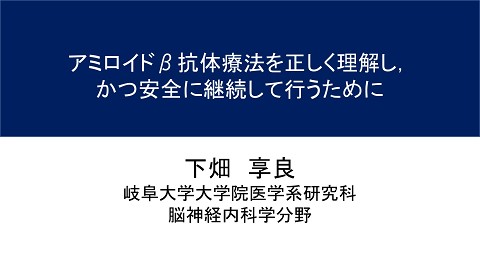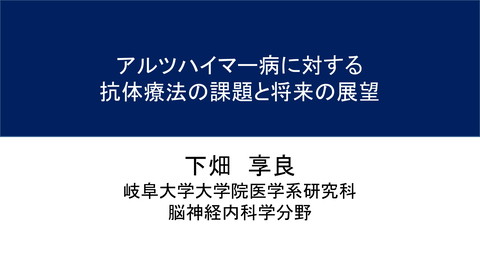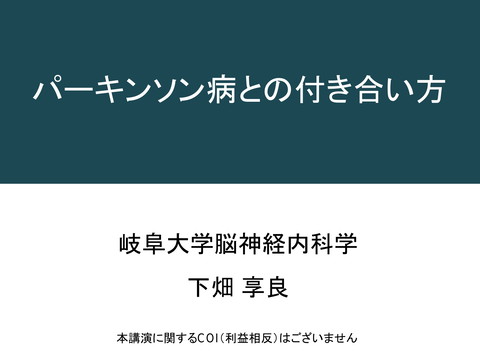シャルコー生誕200年記念式典での講演
1.1K Views
July 05, 25
スライド概要
「Kinnosuke Miura and Jean-Martin Charcot: A Master-Disciple Legacy in Modern Japanese Neurology」という講演のスライドです.
岐阜大学大学院医学系研究科脳神経内科学分野 教授
関連スライド
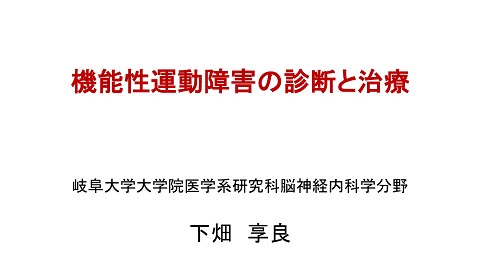
機能性神経障害の診断と治療
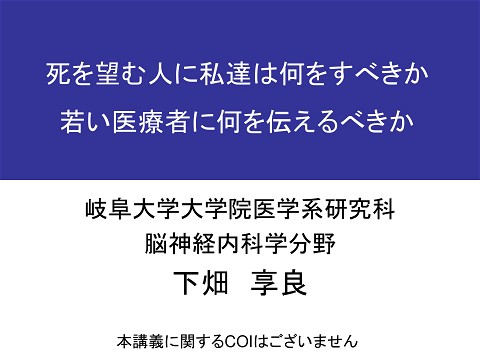
安楽死・医師介助自殺の倫理
各ページのテキスト
Kinnosuke Miura and Jean-Martin Charcot: A Master-Disciple Legacy in Modern Japanese Neurology Takayoshi Shimohata, MD, PhD1 Makoto Iwata, MD, PhD2 1. Department of Neurology, Gifu University Graduate School of Medicine, Japan 2. Medical Clinic Kakinokizaka
Self-introduction • I am a Japanese neurologist and a professor at a national university. I am also a board member of the Japanese Society of Neurology. • In May of this year, events such as exhibitions, symposiums, roundtable discussions, and book publications were held in Japan to celebrate the bicentennial of Charcot’s birth. • Today, I would like to introduce Professor Charcot’s significant influence on Japanese neurology through Dr. Kinnosuke Miura.
*The Japan Neurological Society Special Program “Charcot and Neurology” A symposium on “Charcot and Neurology” was held as a special program for the 200th anniversary of Charcot's birth at the annual meeting of the Japanese Society of Neurology held on May 21, 2025. Dr. Makoto Iwata (co-presenter)
Exhibition corner celebrating the bicentennial of Charcot's birth In conjunction with the symposium, a display area with exhibits related to Charcot and Kinnosuke Miura was also set up.
* Memorial book “The Century of Charcot (2025)” This book was published as a record of the roundtable discussion titled “The Century of Charcot”.
Introduction • During the pandemic caused by COVID-19, I treated many patients with functional neurological disorders (FNDs). • I was interested in how Prof. Charcot dealt with the increase in the number of patients suffering from hysteria during the Franco-Prussian War. • During my study with Prof. Charcot, I became interested in the teacher-student relationship between Prof. Charcot and his Japanese student, Dr. Kinnosuke Miura.
Dr. Miura regarded Charcot as a lifelong mentor. • Dr. Miura was a Japanese physician, particularly in the field of neurology. • In 1890, he studied in Germany, France, and Paris under Prof. Charcot. • At the time, Prof. Charcot was 67, and Dr. Miura was 28. Although he studied under Prof. Charcot for less than 8 months, Dr. Miura regarded Prof. Dr. Kinnoske Miura(1864-1950) Charcot as a lifelong mentor.
I wanted to know why Dr. Miura regarded Prof. Charcot as his lifelong mentor despite his short study abroad period. To understand this, we collected books written by Miura's descendants and examined the documents in which Dr. Miura talked to Prof. Charcot. Memoirs of a Medical Scientist's Life Norihiko Miura (eldest son) 150 Years of Medical Scientists Yoshiaki Miura (second son) Memories of my grandfather, Miura Kinnosuke Yasusada Miura (grandson)
Dr. Miura’s family around 1915. Kinnosuke, his wife Noriko, his eldest son Norihiko, and his second son Yoshiaki.
Before Miura met Charcot Charcot as seen by Miura Miura after returning to Japan
Background of Dr. Kinnosuke Miura. • In 1864, Dr. Miura was born in Date City, Fukushima Prefecture. • He then moved to Tokyo in 1877. After studying German at a foreign language school, he entered the Tokyo Imperial University School of Medicine. • In 1887, he graduated and became a research assistant to Prof. Erwin von Bälz, publishing a paper on the “mydriatic effect of ephedrine.”
Dr. Miura was influenced by Bälz but was unable to learn much about neurology. • Erwin von Bälz(1849-1913)was a German Empire doctor invited to Japan in 1876. • He taught modern Western medicine to the Japanese medical community for 27 years, laying the foundations for modern medicine in Japan. • Dr. Miura, who was 23 years old, studied pathology and internal medicine as an assistant to Prof. Bälz. • At the time, no departments in Japan specialized in neurology. Prof. Erwin von Bälz(1849-1913)
At 26-28 (1890-1892), Dr. Miura went to Germany at his own expense. • Dr. Miura studied internal medicine with Prof. Carl Jakob Adolf Christian Gerhardt, neurology with Prof. Oppenheim Hermann in Berlin, and neurology with Prof. Wilhelm Heinrich Erb in Heidelburg. • When Dr. Miura consulted Prof. Gerhardt regarding his future interest in studying neurology, Prof. Gerhardt immediately recommended Prof. Charcot and said he would introduce Dr. Miura to Prof. Charcot. Carl Jakob Adolf Christian Oppenheim Hermann Gerhardt(1833-1902) (1859-1919) Wilhelm Heinrich Erb (1840-1921)
At 28 (early 1892), he went to France to study, which he had not planned. • I assumed that Dr. Miura had a hard time because he did not understand French, but he later stated the following in his lecture: • “I had no choice but to listen to the various lectures at the Paris Medical School from morning till night. After approximately one week, I became accustomed to the lectures and began to hear them. You should take this shortcut when going to France.” • Dr. Miura mastered French quickly and wrote a paper on three patients with hysterical monoplegia in 1892, the year he studied abroad.
Dr. Miura said that Prof. Charcot was a kind man. • Dr. Miura was invited to a dinner party at Charcot's residence, where distinguished guests gathered and learned how to store wine and prepare a party menu from Prof. Charcot. • In another episode, Dr. Miura politely declined when Prof. Charcot recommended riding in his carriage on the way to the hospital in the morning. However, Prof. Charcot further recommended he ride with him, saying, “because the hospital grounds are so large.” Whenever Dr. Miura described this episode, he would always shed tears in the memory of Prof. Charcot.
Before Miura met Charcot Charcot as seen by Miura Miura after returning to Japan
Dr. Miura described Prof. Charcot's personality as follows: “Both Pasteur and Charcot are soft and easy to get along with. They are not arrogant. We are ordinary students, but when we go and talk to them, they talk to us like we're colleagues. However, they did not seem to make such distinctions. Pasteur and Charcot are kind to people, like their assistants.” Louis Pasteur (1822-1895) Jean-Martin Charcot (1825-1893)
*Personality Dr. Miura described of Prof. Charcot Prof. Charcot's as seen personality by Dr. Miuraas(2) follows: • Dr. Miura also said that Prof. Charcot liked to drink with young students. • One night, the ward at Salpêtrière Hospital was noisy until late at night, so the chief nurse went to give them a warning; however, when she opened the door, Prof. Charcot stood in front of her, so she stepped back. Marguerite Bottard (1822-1906) • The next day, Prof. Charcot received a warning from her. マルグリット・ボタール Walusinski O. Eur Neurol. 2011;65:279-85.
Dr. Miura spoke about the work carried out by Prof. Charcot as follows: • “In the West, there are two types of excellent clinicians: those who carefully observe and gain experience and those who do a lot of work (such as writing papers). Prof. Charcot was both of these. We should be like that, too.” • “Prof. Erb only gave ordinary clinical lectures, and, unlike Prof. Gerhard, he was not particularly detailed about ward rounds. Prof. Charcot examined patients in detail.”
Dr. Miura spoke about the diagnostic methods used by Prof. Charcot as follows: “Prof. Charcot placed great importance on observing things. When observing, he first looks at the whole picture and then moves on to the details. This was the same as when looking at a specimen under a microscope; we first looked at the whole picture at low magnification and then moved on to high magnification. This was also the case with Prof. Virchow, a German physician and pathologist.” Rudolf Ludwig Karl Virchow (1821ー1902)
*Charcot's method of diagnosis (Augenblicksdiagnose) Semin Neurol 18:169-76, 1998 • Dr. Miura said that despite being French, Prof. Charcot often used the German term Augenblickdiagnose (Augenblick = instantaneous). • This is the sixth sense doctors have when they see a patient entering a room or a diagnosis made instantly based on characteristic physical signs. • Prof. Charcot would make this Augenblickdiagnose, keep it in mind, and then make a final diagnosis after two weeks of detailed examination. The Augenblickdiagnose often matched autopsy results.
Dr. Miura also discussed Charcot's preparations for the “Tuesday Lectures”. • “Prof. Charcot would call patients to his room every day, and for at least two weeks, he and his students would observe the patients, after which they would be opened to the public. I was fortunate enough to be allowed to participate in these sessions, and I observed patients with my professor”. • “Prof. Charcot would then go home, look up the literature, examine the patients again the next day, and finally give a lecture in the lecture hall, so what he talked about there was well-organized”.
Before Miura met Charcot Charcot as seen by Miura Miura after returning to Japan
After returning to Japan, Dr. Miura sent two letters to Prof. Charcot. Dr. Miura wrote to Charcot to express his heartfelt thanks for the kindness and hospitality he had received while pursuing his studies in Paris. Miura K. Neurological Medicine 62:1-4, 2005
Dr. Miura's letter to Prof. Charcot contained important information on Japanese neurology. Iwata M. Kagaku-igaku shiryo kenkyu 251:8-12, 1995 • The first letter reports on the places he visited and the diseases he had seen there. • The second letter, a New Year's greeting for 1893, contained a very important note: “I was now practicing general internal medicine, but in the future, I wished to focus my practice on neurological diseases. ・・・・・ I will propose setting up a department of neurological diseases in the hospital at our university's medical school.” • In the same year (1893), Prof. Charcot passed away.
In 1894, a proposal was made to the Imperial Parliament to establish a neurology department. Kuzuhara S.Rinsho Shinkeigaku 60:1-19, 2020 • Dr. Tai Hasegawa, who developed medical care in the Meiji era, proposed to the Imperial Parliament that the Tokyo Imperial University should establish a new department and ward for the study of neurological disorders, independent of ordinary internal medicine, as in Europe (particularly France), with Dr. Kinnosuke Miura as Professor. The proposal was referred to an investigation by nine members, but it was not approved. • In 1895, Dr. Miura was appointed Professor in the First Department of Internal Medicine at the Tokyo Imperial University. Subsequently, the establishment of the Department of Neurology disappeared, and neurology gradually declined, partly because Dr. Miura himself changed his position to focus on the establishment of internal medicine.
It took 70 years for neurology to become an independent field in Japan. Iwata M. Kagaku-igaku shiryo kenkyu 251:8-12, 1995 • It was in 1964 that neurology, introduced from the United States after World War II, became an independent academic discipline in Japan. • However, 70 years earlier, Prof. Miura proposed that neurology should be established as an independent academic discipline and have its own university course. • Furthermore, the model for this was the French neurology established by his mentor Prof. Charcot. If this had been realized, the course of Japanese neurology would have differed entirely from what it is today.
At the age of 31, Dr. Miura became a professor. A Takahashi.Neurological Medicine 51:1-12, 1999 A takahashi.Rinsho Shinkeigaku 53:926‒929, 2013 Dr. Miura energetically researched on diseases such as Kubisagari (dropped head syndrome). • This disease presents with a dropped head, ptosis, mastication disorder, and weakness of the trunk and extremities. It differs from myasthenia gravis due to its regional and familial occurrence, paroxysmal nature, and good prognosis. • Prof. Miura thought it was worth reporting to Prof. Charcot, so he traveled far away to see the patients. • He spent a lot of time investigating the patients, but when he heard the news of Prof. Charcot‘s death, he became discouraged, lost interest in writing, and wrote only one article in Japanese.
He wrote a paper on hysteria. • Miura K. Sur trois cas de monoplégia brachiale hystériques. Archives de neurologie. xxv (75):321-356. 1893 スュール トロワ カ ドゥ モノプレジア ブラキアル イステリック • This is a summary of 28 patients with hysterical monoplegia of the upper limbs reported in France between 1885 and 1890, to which Dr. Miura added three patients he had diagnosed. This paper was cited in Pierre Janet's doctoral thesis. • The characteristics of each patient and the treatment process, which aimed to have a psychological effect using static electricity and grip-strength meters, are described. • Dr. Miura may have tried to carry on the core of Prof. Charcot's theory of hysteria more than anyone.
*Even after Prof. Charcot's death, Dr. Miura followed his teachings. • After Charcot's death, Dr. Babinski developed the concept of pithiatisme, emphasizing that hysteria is a reversible functional disorder caused by suggestion. • Dr. Babinski was interested in distinguishing between hysteria and organic diseases and used the Babinski sign to differentiate between functional paralysis and organic paralysis. • Dr. Miura was skeptical of this Babinski's ideas and remained faithful to Charcot's teachings. Perhaps for this reason, he was closer to Dr. Pierre-Marie than Dr. Babinski. Joseph Jules François Félix Babinski (1857-1932)
In 1914, Prof. Miura gave two of 24 lectures on hysteria. Tuberculous meningitis due to optic nerve tuberculosis Cerebellopontine angle tumor Left homonymous hemianopia and left hemiplegia (suspected glioma) Homonymous hemianopia with hemiplegia and aphasia Paraphasia (a type of aphasia) Thromboembolism due to mitral valve insufficiency Pontine infarction Multiple cranial nerve palsies Neurosyphilis and central diabetes insipidus Neurosyphilis (general paresis) Amyotrophic lateral sclerosis (bulbar type) Spinal cord hemorrhage (intraspinal hemorrhage) Muscular dystrophy Ophthalmoplegic migraine (migraine with tremor) Hysteria (with tonic seizures) Tetany (due to hypocalcemia, etc.) Huntington’s disease or Sydenham’s chorea Hysteria (with psychogenic seizures and conversion aphonia) Spasmodic torticollis and chronic kidney disease Intermittent claudication Addison’s disease Clinical diagnosis of liver disease Liver cirrhosis Considerations on acupuncture therapy This is a list of the 24 lectures delivered by Prof. Miura, two of which were on the subject of hysteria.
Dr. Miura also wrote papers on cerebellar ataxia and ALS. • Marie's Hereditary Cerebellar Ataxia (1898) • Considerations on Amyotrophic Lateral Sclerosis (1902) • Both of these papers were written in German, and each pays tribute to the achievements of Drs. Marie and Charcot, while including their patients, Dr. Miura also discusses his own patients. • Both papers demonstrated Dr. Miura's strong presence as a member of the Salpêtrière School.
In his ALS paper, Prof. Miura mentioned his mentor Charcot. • This article is a clinicopathological report of two patients with ALS. • It begins with the following statement: • “Since 1865, my mentor, Prof. Charcot, has been describing ALS as a special disease, and since the end of 1872, when he completed the description of this disease, there has been no need to add to the description of the disease.” The cover of the book Table of Contents of Vol.1
As an educator, Prof. Miura told his students and young staff members the following: “Make sure to spend at least two hours a day reading books.” “Even if Japanese scholars do good work, they are unable to compete on the world stage because of their lack of language skills and poor presentation methods, despite their best efforts.”
Dr. Miura, after retiring from his professorship in 1924. A Takahashi.Neurological Medicine 51:1-12, 1999 A takahashi.Rinsho Shinkeigaku 53:926‒929, 2013 • Due to his close relationship with the imperial family, including his treatment of the Meiji and Taisho Emperors, he was invited by the Imperial Household Agency Hospital as a court physician. • However, following the example of Prof. Charcot, who treated many ordinary patients, he declined the invitation. He worked as the director of Doai Hospital, which was established with American assistance after the Great Kanto Earthquake.
Prof. Miura was appointed director of the Japan-France Society and tried to become a “bridge” between Japan and France. • The Japan-France Society was an organization that aimed to promote cultural, economic, and academic exchanges between Japan and France. • This postcard was written in 1948 and replied to his acceptance of the directorship. Presenter's collection
*The End of Professor Miura's Life • In 1950 (at 87), Prof. Miura suddenly passed away from a pontine hemorrhage. • Prof. Miura's grave is in the Yanaka Cemetery in Taito Ward, Tokyo. I visited it to pay my respects and report on my presentation on the 200th anniversary of Charcot's birth.
Discussion
Dr. Miura admired Prof. Charcot as a clinician. • Dr. Miura believed that Prof. Charcot had two sides to his personality: as a clear-thinking theorist and scientist and as a flexible and excellent clinician. • Regarding the latter, even when there were few effective treatments available, Prof. Charcot would try general treatments if there was a possibility that they would improve symptoms. • Prof. Miura also tried various treatments, just like Prof. Charcot. • He was proud to have been a direct student of Prof. Charcot until his final years.
Prof. Charcot had a direct impact on clinical neurology in Japan. • Japanese clinical neurology is often mistakenly thought to have originated from Prof. Tadao Tsubaki and Prof. Yoshigoro Kuroiwa, who studied in the United States after World War II but was introduced from France long before: (i) through Prof. Miura, a student of Charcot, and (ii) through Dr. Tsunemaru Sato, who translated Charcot's Tuesday Lectures into Japanese. Dr. Tsunemaru Sato
These kanji mean “Prof. Charcot”. This is a Japanese translation of the Tuesday Lectures delivered by Dr. Sato.
Conclusion • The French neurology established by Prof. Charcot was passed on to Prof. Miura along with its spirit. • Although Prof. Miura studied under Prof. Charcot for less than eight months, it greatly impacted both Prof. Miura himself and Japanese neurology. • On May 25, 1925, the Centennial anniversary of Prof. Charcot's birth, Prof. Miura sent a telegram to Paris and sent a vase of flowers to be placed in front of Charcot's statue. This year marks the 200th anniversary of Charcot's birth. We would like to take this opportunity to examine Profs. Charcot and Miura’s achievements. Thank you for your kind attention!!
